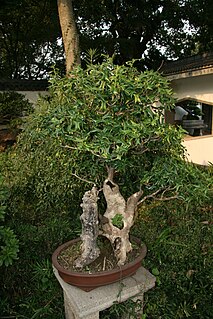
The horned screamer is a member of a small family of birds, the Anhimidae, which occurs in wetlands of tropical South America. There are three screamer species, the other two being the southern screamer and the northern screamer in the genus Chauna. They are related to the ducks, geese and swans, which are in the family Anatidae, but have bills looking more like those of game birds.

Corylus cornuta, the beaked hazelnut, is a deciduous shrubby hazel with two subspecies found throughout most of North America. The Eastern beaked hazel is found from southern Canada south to Georgia, while the Western beaked hazel occurs along the west coast from Alaska to California.

The Surinam horned frog, also known as Amazonian horned frog, is a bulky frog measuring up to 20 centimetres (7.9 in) found in the northern part of South America. It has an exceptionally wide mouth, and has horn-like projections above its eyes. Females lay up to 1,000 eggs at a time, and wrap them around aquatic plants. The frog eats other frogs, fish, lizards, and mice. Tadpoles of the Surinam horned frog attack each other soon after being hatched. This species was once considered the same species as Ceratophrys ornata. This dispute was later settled because the Surinam Horned frog inhabits a different habitat than its smaller cousin and does not interbreed with it in the wild. This species has been known to prey upon the other species of horned frog, especially the northern race of Ceratophrys ornata.

The many-horned adder is a venomous viper species found in certain rocky desert areas, mostly along the Atlantic coast of southern Africa. They have characteristic tufts of "horns" above each eye. no subspecies are currently recognized.

The Wych Elm cultivar Ulmus glabra 'Cornuta', in cultivation before 1845 – Fontaine (1968) gives its provenance as France, 1835 – is a little-known tree, finally identified as a cultivar of U. glabra by Boom in Nederlandse Dendrologie 1: 157, 1959.

The horned marsupial frog, originally named Nototrema cornutum Boulenger after the first describer George Albert Boulenger in 1898), is a species of frog in the family Hemiphractidae. It is an arboreal species found in Colombia, Costa Rica, Ecuador and Panama. Its natural habitats are tropical moist lowland forests and montane cloud forests. It is threatened by habitat loss.

Crematogaster is an ecologically diverse genus of ants found worldwide, which are characterised by a distinctive heart-shaped gaster (abdomen), which gives them one of their common names, the Saint Valentine ant. Members of this genus are also known as cocktail ants because of their habit of raising their abdomens when alarmed. Most species are arboreal. These ants are sometimes known as acrobat ants.

Crematogaster pilosa species of ant in the subfamily Myrmicinae. It is native along the southern Atlantic coast of the United States and some interior areas. These polydomous ants have been found living in tidal marshes, wet meadows and other environments in plant stems, logs, and fallen branches.

Utricularia cornuta, the horned bladderwort, is a small to medium-sized, probably perennial carnivorous plant that belongs to the genus Utricularia. U. cornuta is endemic to North America and can be found in the Bahamas, Cuba, Canada, and the United States. It grows as a terrestrial or subaquatic plant in marshes, swamps, and pools in shallow waters, mostly at lower altitudes. It was originally described and published by André Michaux in 1803.

Crematogaster ashmeadi, commonly known as the acrobat ant, is an arboreal ant widespread in the Southeastern United States. It nests and forages almost exclusively above ground level, often found in treetops and on lianas. It is one of eleven species in the genus Crematogaster that is native to eastern North America. This ant species has been observed to raid wasp nests, including the species Mischocyttarus mexicanus, and to forage on their brood. It is the most dominant arboreal ant in the pine forests of the coastal plains of northern Florida. Colonies of these ants inhabit a majority of pine trees in the area, living in chambers in the outer bark of living trees that have been abandoned by bark-mining caterpillars, usually of the family Cossidae. C. ashmeadi does little to no excavation of its own, relying solely on chambers bored out by other insects.

Ilex cornuta, commonly known as Chinese holly or horned holly, is a slow-growing, densely foliaged evergreen shrub in the Aquifoliaceae plant family. It is native to eastern China and Korea and attains a height of about 3 metres (9.8 ft). The leaves are usually 5-spined, between 3.5 cm and 10 cm long, oblong and entire. The fruits are red berries, which are larger than those of the European Holly.

Crematogaster peringueyi is a southern African arboreal species of ant. They are commonly known as the black cocktail ant or swartwipgatmier (Afrikaans) for their colour and habit of arching their tails when alarmed.

Crematogaster carinata is a species of ant in the tribe Crematogastrini. It was first described by Gustav Mayr in 1862. It is native to Central and South America, where it is a common species, forming large colonies in the canopy of the forest.
Crematogaster rothneyi, is a species of ant of the subfamily Myrmicinae.

Cornuta is an extinct order of echinoderms. Along with the mitrates, they form one half of the Stylophora.
The Wych Elm cultivar Ulmus glabra 'Grandidentata', listed as U. glabra var. grandidentata (Moss), may have been the tree first described by Dumortier in Florula Belgica, 25, 1827, as U. corylacea var. grandidentata, in cultivation before 1830. Green thought it a synonym of 'Cornuta'. 'Grandidentata' may be synonymous with U. glabra 'Corylifolia', which Green thought another synonym of 'Cornuta'.
Tetraponera penzigi, is a species of ant of the subfamily Pseudomyrmecinae, which can be found in East Africa. It forms an obligate symbiosis with the whistling thorn, a dominant tree in some upland areas of East Africa.













